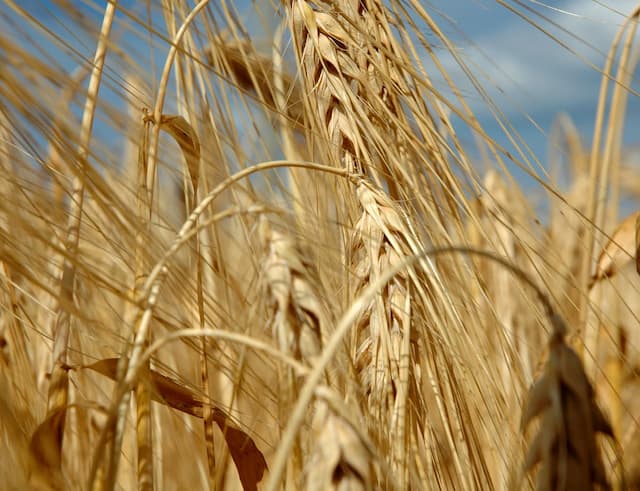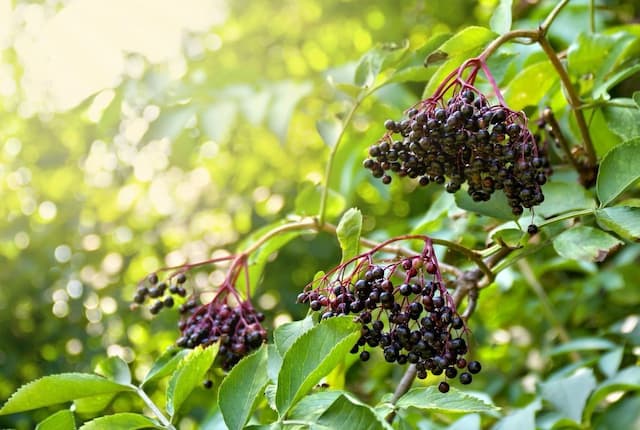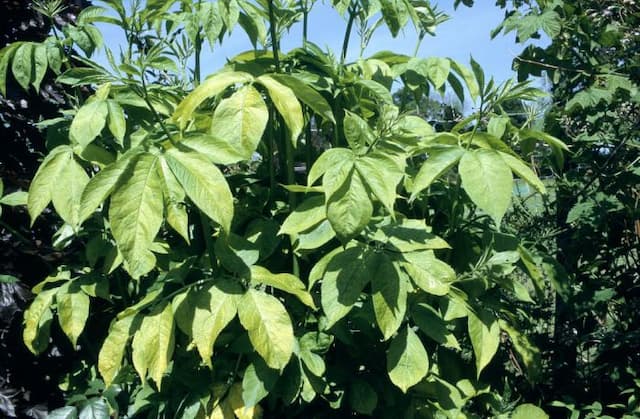Arrowwood Viburnum Viburnum 'Le Bois Marquis' (PBR)

ABOUT
Viburnum 'Le Bois Marquis' is a visually striking plant recognized for its appealing aesthetic qualities. This particular variety of Viburnum showcases dense, luscious foliage that remains attractive throughout the year. Its leaves are characterized by a deep green color, which can develop purplish or bronze nuances during the colder months, adding to the visual interest of the plant. Get even more value out of this variety when spring arrives and it becomes adorned with clusters of fragrant flowers. These flowers are typically white and have a remarkably appealing scent, which adds an olfactory dimension to its beauty. After the floral display, the plant may produce berries which initially appear red and then ripen into a dark, almost blackish hue. These berries can attract birds and other wildlife, bringing life and dynamic interaction to garden spaces. Overall, Viburnum 'Le Bois Marquis' possesses a rounded and bushy appearance, which makes it an excellent choice for adding structure and elegance to landscaping.
About this plant
 Names
NamesFamily
Adoxaceae.
Synonyms
Mariesii Doublefile Viburnum, Doublefile Viburnum, Japanese Snowball.
Common names
Viburnum 'Le Bois Marquis' (PBR).
 Toxicity
ToxicityTo humans
Viburnum, including the 'Le Bois Marquis' variety, is generally not considered toxic to humans. However, the berries may cause mild stomach upset if ingested in large quantities. Common symptoms of eating large amounts of viburnum berries might include nausea, vomiting, and diarrhea. Overall, viburnum is not known for serious toxic effects in humans, but it is still advisable to avoid ingesting parts of this plant.
To pets
Viburnum, including the 'Le Bois Marquis' variety, is also generally considered non-toxic to pets. Much like in humans, if pets consume large amounts of the berries, they might experience mild gastrointestinal upset. Symptoms can include vomiting and diarrhea. There is no widespread evidence of severe toxicity in pets from ingesting viburnum, but it is still best to prevent pets from eating plants as a general precaution.
 Characteristics
CharacteristicsLife cycle
Perennials
Foliage type
Semi-deciduous
Color of leaves
Varies
Flower color
White
Height
6 feet (1.83 meters)
Spread
6 feet (1.83 meters)
Plant type
Shrub
Hardiness zones
5
Native area
Europe
Benefits
 General Benefits
General Benefits- Ornamental Appeal: Adds aesthetic value to landscapes and gardens with its attractive foliage and flowers.
- Seasonal Interest: Features vibrant autumn colors and spring blossoms, adding year-round interest to garden spaces.
- Low Maintenance: Requires minimal care compared to other ornamental plants, making it suitable for busy gardeners.
- Habitat Support: Provides food and shelter for birds and beneficial insects, supporting local biodiversity.
- Privacy Screening: Can be used as a hedge or screen to provide privacy and reduce noise pollution.
- Durability: Exhibits good resistance to common pests and diseases, ensuring a long-lasting presence in the garden.
- Hardiness: Tolerates a range of soil types and environmental conditions, making it adaptable to various climates.
 Medical Properties
Medical PropertiesThis plant is not used for medical purposes.
 Air-purifying Qualities
Air-purifying QualitiesThis plant is not specifically known for air purifying qualities.
 Other Uses
Other Uses- Dye Production: The berries of Viburnum can be used to make a natural dye for textiles, yielding shades of blue and purple depending on the mordant used.
- Insect Repellent: Crushing the leaves and applying the oils can help deter mosquitoes and other insects, although it's not as effective as commercial repellents.
- Photography: Viburnum plants, with their attractive foliage and berries, are excellent subjects for botanical photography and can be used in portfolios or art exhibits.
- Privacy Screening: With its dense growth, Viburnum can be planted to create a natural privacy screen in residential or commercial landscapes.
- Culinary Garnish: While not a common practice, the flowers of some Viburnum species might be used as a decorative garnish for certain dishes.
- Sound Barrier: The thick foliage of Viburnum can help absorb sound, making it useful for planting along roads or in urban gardens to reduce noise pollution.
- Winter Interest: Due to its evergreen nature and the persistence of berries into the winter, Viburnum can be used to maintain visual interest in gardens during the colder months.
- Crafts: Dry Viburnum branches and berries can be used in floral arrangements, wreaths, or other crafts for home decoration.
- Educational Tool: The species can be used in educational settings such as botanic gardens or schools to teach plant identification and horticulture.
- Soil Stabilization: Viburnum's root system can help prevent erosion, making it useful for planting on slopes or in areas prone to soil degradation.
Interesting Facts
 Feng Shui
Feng ShuiThe plant Viburnum is not used in Feng Shui practice.
 Zodiac Sign Compitability
Zodiac Sign CompitabilityThe plant Viburnum is not used in astrology practice.
 Plant Symbolism
Plant Symbolism- Renewal: The Viburnum often blooms early in spring, representing new beginnings and the renewal of life.
- Protection: Some species of Viburnum have been historically used to ward off evil spirits, symbolizing safety and protection.
- Abundance: With its generous clusters of flowers, Viburnum can signify wealth, prosperity, and abundance.
 Water
WaterThe Arrowwood Viburnum should be watered deeply once a week during its growing season, ensuring moisture reaches the roots. In hot and dry conditions, increase the frequency to twice a week, supplying about 1 inch of water each session. During winter or when the plant is dormant, reduce watering to twice a month, or when the topsoil feels dry to the touch, to avoid overwatering. Always check the soil moisture level before watering to make certain the plant is not being over-irrigated.
 Light
LightArrowwood Viburnum thrives in full sun to partial shade. The ideal spot for this plant would be in an area where it can receive at least 4 to 6 hours of direct sunlight daily, supplemented with light, dappled shade during the hottest parts of the day to protect it from scorching. Avoid deep shade locations as this could hinder its growth and flowering potential.
 Temperature
TemperatureArrowwood Viburnum grows best in a range of temperatures, ideally between 60 to 75 degrees Fahrenheit. It can tolerate cold down to about -10 degrees Fahrenheit, but should be protected from extreme cold spells. This plant is quite hardy and adaptable, but consistently extreme temperatures outside of its comfort zone could cause stress.
 Pruning
PruningPrune Arrowwood Viburnum to maintain shape and encourage healthy growth, typically after it flowers in late spring to early summer. Remove dead or diseased branches, and thin out old wood to rejuvenate the plant every few years. Pruning can also be done to control the size of the shrub if necessary, but always prune moderately to avoid excessive damage.
 Cleaning
CleaningAs needed
 Soil
SoilFor Viburnum 'Le Bois Marquis', commonly known as Arrowwood viburnum, the best soil mix is well-draining with high organic matter. A mix of garden soil, compost, and peat moss is ideal. This plant prefers a slightly acidic to neutral soil pH of 5.6 to 7.0 for optimal growth.
 Repotting
RepottingArrowwood viburnum typically does not require frequent repotting as it is a slow-growing shrub. When grown in containers, it may need repotting every 3 to 5 years to refresh the soil and provide room for root growth.
 Humidity & Misting
Humidity & MistingArrowwood viburnum is adaptable to a range of humidity levels and does not require specific humidity conditions. It thrives in outdoor environments where the humidity naturally fluctuates.
 Suitable locations
Suitable locationsIndoor
Place in bright light, water when topsoil is dry.
Outdoor
Full sun to partial shade, moist, well-drained soil.
Hardiness zone
5-8 USDA
 Life cycle
Life cycleThe life cycle of Viburnum 'Le Bois Marquis', commonly known as the Wayfaring Tree, begins with seed germination, which typically occurs in a moist, well-drained soil environment. Following germination, the seedling stage is characterized by initial shoot and root development as the young plant establishes itself. After the seedling phase, the plant enters the vegetative stage, where it develops a robust root system and foliage, eventually forming a mature shrub. As the Wayfaring Tree reaches maturity, it enters the flowering stage, producing clusters of creamy white flowers that are succeeded by berry-like fruits (drupes) if pollination occurs. These fruits facilitate seed dispersal, either by animals or natural elements, leading to a new generation of plants. Finally, as a perennial, the Wayfaring Tree may go through multiple cycles of growth, flowering, and seed production throughout its lifespan, which can be several decades long.
 Propogation
PropogationPropogation time
Spring-Early Summer
The Viburnum 'Le Bois Marquis', also known as the Arrowwood Viburnum, can be propagated most commonly through semi-hardwood cuttings. This method typically takes place during the late summer months. To propagate, one would cut a semi-hardwood stem that has matured slightly from the current year's growth. The cutting should be about 4 to 6 inches (approximately 10 to 15 centimeters) long, with several leaves attached. To encourage rooting, the bottom end of the cutting is often dipped in rooting hormone powder before being planted in a well-draining soil mix. The soil should be kept consistently moist but not waterlogged and the cuttings should be placed in indirect light. With proper care, roots will usually develop within a few weeks.




![Elder [Black Tower]](/_next/image?url=https%3A%2F%2Fplants-admin.emdemapps.com%2Fimages%2Fplants%2F%2Fimages%2F604b5cad99578.png&w=640&q=75)




